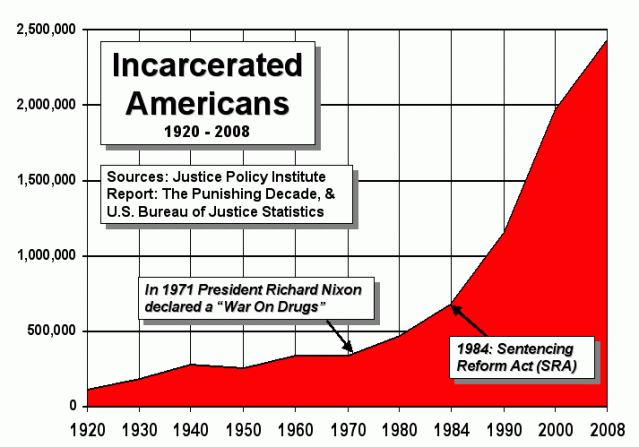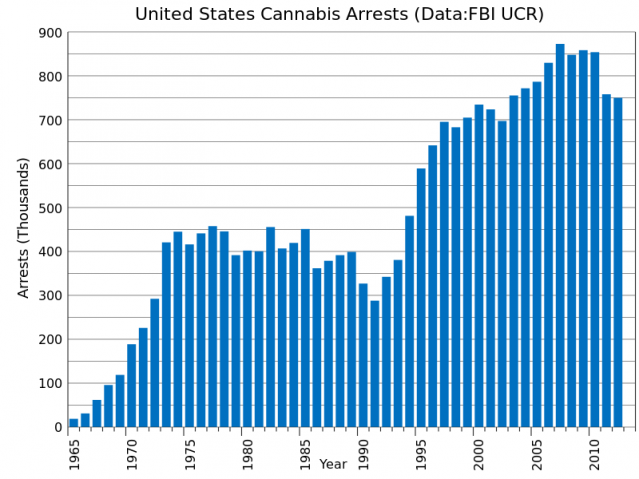Education
The War on Drugs and College Student Debt
Funding the War on Drugs leads to a rise in college student debt.
Posted September 2, 2014
A lot has been written about the War on Drugs and about college student debt, but rarely are the two issues connected. I would argue, however, that the transfer of funds from higher education to the War on Drugs is one of the main causes of the dramatic rise in higher education student debt.
The overwhelming proportion of individuals both participating in higher education and engaged in criminal activities are in their teens and twenties. So the first observation we need to make is that these are two different career tracks that society provides for young people in their transition to adulthood. One leads to economic self-sufficiency and productive participation in society, and the other leads to social marginalization and social costs.
The next observation is that, beginning with Richard Nixon’s 1971 declaration of a War on Drugs, and escalating under president Reagan and thereafter, the American prison population skyrocketed; for quite a while now we have been the country with the largest proportion of the population incarcerated. Figure 1 shows this dramatic acceleration in the U.S., while Figure 2 shows that other developed countries--Europe (an average, shown in green), Canada (brown), Japan (blue), and Australia (grey)--remain at levels similar to what ours was before the incarceration explosion. Of the countries compared, only Russia (red) and South Africa (orange) are out of line with the rates in the developed world, and neither approaches us.

Figure 1: Incarcerated Americans 1920-2008

Figure 2: United States is the World’s Leading Jailer
The two main reasons for the huge increase in our prison population are the War on Drugs, which criminalizes many activities, and mandatory minimum sentences, which keep people in jail longer. A sense of the magnitude of the War on Drugs can be seen in Figure 3, which shows the growth of marijuana arrests in the United States.

Figure 3: United States Cannabis Arrests 1965-2012
An additional cause of the increase in the number of people incarcerated is the privatization of prisons in some states (e.g., Louisiana), where profits are used to lobby legislators to increase both the number of crimes and the lengths of prison sentences.
At the same time that our prison population has exploded, the cost of college has also been going up. However, public support for higher education has been going down, so students have had to borrow increasing amounts of money to make up the difference. I would argue that a key reason for the decline in public support for higher education is that the funds are being spent on the criminal justice system in general, and on incarceration in particular.
The total cost of putting a young adult in prison for a year--even for a non-violent crime like possession of marijuana--is roughly the same as the total cost of putting an age-mate through a year of college. So the question of where society wants to invest its money is clearly drawn.
It might be argued that most people who go to college are different from most who get arrested for drugs--but this only strengthens the case for legalization and sentencing reform. That is, by diverting funds from the criminal justice system to higher education, society would be helping people who can't afford college, and also helping those who would avoid prison and thereby have improved job prospects because they lack a criminal record. Society as a whole would also benefit by having a better-educated labor force.
To me the message is clear--to deal with student debt we need to reverse our decades-old policy of diverting funds from education to the War on Drugs.
Image Sources:
US incarceration timeline by The November Coalition
http://commons.wikimedia.org/wiki/File:US_incarceration_timeline.gif
Incarceration rates worldwide by The November Coalition
http://commons.wikimedia.org/wiki/File:Incarceration_rates_worldwide.gif
Arrests for cannabis in the United States each year from 1965 to 2012, from the FBI Uniform Crime Reports.
http://commons.wikimedia.org/wiki/File:US_Cannabis_Arrests.svg
Check out my most recent book, The Myth of Race, which debunks common misconceptions, as well as my other books at http://amazon.com/Jefferson-M.-Fish/e/B001H6NFUI
The Myth of Race is available on Amazon http://amzn.to/10ykaRU and Barnes & Noble http://bit.ly/XPbB6E
Friend/Like me on Facebook: http://www.facebook.com/JeffersonFishAuthor
Follow me on Twitter: www.twitter.com/@jeffersonfish
Visit my website: www.jeffersonfish.com


